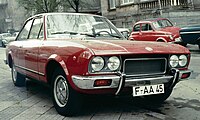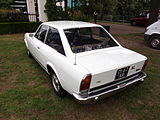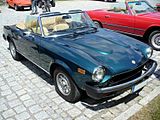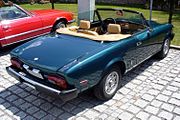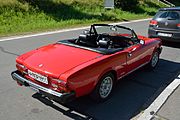Fiat 124
| Fiat | |
|---|---|
|
Fiat 124 sedan (1966-1970)
|
|
| 124 | |
| Production period: | 1966-1985 |
| Class : | Lower middle class |
| Body versions : | Sedan , station wagon , coupé , spider |
| Engines: |
Petrol engines : 1.2 liters (44–49 kW) 1.4 liters (51–66 kW) 1.6 liters (70–81 kW) 1.8 liters (65–86 kW) 2.0 liters (63–100 kW) |
| Length: | 4042-4045 mm |
| Width: | 1625 mm |
| Height: | 1420-1440 mm |
| Wheelbase : | 2420 mm |
| Empty weight : | 855-950 kg |
| Previous model | Fiat 1300 |
| successor | Fiat 131 |
The Fiat 124 is a lower middle class model of the Italian car brand Fiat , which was built in different variants (vehicle categories) between spring 1966 and summer 1985. As a limousine, it was voted Car of the Year 1967 by specialist journalists in the European motor press . Fiat issued licenses to build the 124 in several countries. Together with the licensed replicas, including around 17.3 million copies of the Schiguli , the Fiat 124, with a production volume of almost 23 million, is one of the most-produced automobile designs after the Beetle and before the Ford T.
Since 2016 Fiat has been offering a new sports model (Roadster) based on the Mazda MX-5 from 2016 under the model name Fiat 124 Spider .
Model history
General
Shortly after the presentation of the Fiat 1300 and Fiat 1500 series , Fiat began work on developing a successor. Since the stylistic " New Objectivity " had found its way into automobile construction in the early 1960s , the design of the new Fiat 124 should also be based on this trend.
At that time, Fiat only built rear-wheel drive vehicles . However, the front-wheel drive has been regarded as trend-setting for the mass market at least since the presentation of the BMC Mini on the car market. Within the Fiat group, Autobianchi has already achieved sales successes with the Primula with this concept.
In order to transfer the knowledge gained at Autobianchi to the parent company Fiat, a joint project called 123 was set up in Turin. Based on the Primula , the development of a four-door notchback sedan with transverse engine and front-wheel drive began. In the course of the work, however, Fiat decided to continue producing the future Fiat 124 with rear-wheel drive and surprisingly broke off the collaboration. Autobianchi brought the project to series production on its own and sold the vehicle as the Autobianchi A111 .
Even then, the Fiat group achieved a significant proportion of its sales outside of Italy . This was largely due to the licensed productions of subsidiaries that sold the vehicles under their brand names, provided that they matched the respective national needs. The specification for the design of the Fiat 124 was therefore to please as globally as possible and to be able to assert oneself even under difficult conditions. Fiat's solution for this task was a simple, smooth-surfaced shape, paired with robust and proven technology without innovative experiments.
Technical conception
The car had a longitudinally-mounted front four-cylinder engine with 1197 cc capacity with a cylinder head made of aluminum . The compression of the engine of 8.8: 1 also allowed the use of fuels with a low octane number .
The maximum torque was 94 Nm at 3200 rpm. The output was 65 PS according to SAE, that is 60 DIN PS and corresponds to 44 kW. At that time, the five-bearing crankshaft was new in a Fiat .
The power of the engine was transmitted via a four-speed gearbox to the rear rigid axle , which was guided by four trailing arms and a Panhard rod . The braking system included disc brakes on all four wheels (a novelty in this vehicle class), but brake assistance was not standard.
idea
The Fiat 124 was presented to the public in the spring of 1966. The only body variant was initially the four-door sedan. Despite the small dimensions of 4030 mm × 1625 mm × 1420 mm, contemporary testers praised the space in the interior. Compared to the previous model, the window areas have been enlarged considerably, which improves the clarity for the driver. Both the steering wheel with horn ring and the speedometer unit were borrowed from the last development stage of the 1300/1500 model series. Overall, the dashboard and interior had been redesigned. The standard scope of delivery included a fuel meter with a reserve light. The spare wheel was housed in the trunk on the left and the fuel tank on the right .
Customers received the Fiat 124 positively from the start. Even at the start of production, 200 units could be manufactured per day; a number that rose to 600 by the fall of 1966. Fiat continued to develop the model family and in the spring of 1967 presented a station wagon called Familiare. It adopted almost all the features of the sedan, but had 6.15S – 13 tires instead of 5.50S – 13. The tank volume increased from 39 to 47 liters.
Although the Fiat 124 sold well, the performance was criticized as too poor. The 124 Special was therefore presented in November 1968. The engine capacity was increased to 1438 cm³ and the compression increased to 9.1: 1. It achieved a maximum torque of 110 Nm at 3300 rpm and an output of 70 DIN PS (51 kW). This increase in performance essentially benefited the acceleration, the top speed only increased by 5 km / h.
Externally, the Special could be recognized by a modified radiator grille with double headlights , larger bumper horns and modified rear lights with integrated reflectors. The interior was slightly redesigned. The instrument unit in the Special consisted of two round displays. On the left was the speedometer without a trip meter. All displays and warning lights were combined in the right instrument. In order to reduce the driving noise level, an additional 25 kg of insulation material was built into this model.
In November 1970 the vehicles of the first facelift came on the market. The base model of the Fiat 124 received a newly designed radiator grille with four horizontally arranged and chrome-plated strips. The bumper horns were carried over from the 124 Special. The revised rear now had larger taillights with reversing lights. In order to improve the air circulation in the interior of all vehicles, ventilation slots were added to the C-pillar . A dual-circuit brake system with servo assistance increased safety. These changes also benefited the 124 Special. However, the bumper horns were omitted in favor of a circumferential rubber strip. In the interior there were elements with imitation wood.
At the same time, the 124 Special T was added to the program. He had the engine with two overhead, timing belt-driven camshafts from the 124 Coupé and Spider models. The 124 Special T was thus aimed at the successful Alfa Romeo Giulia Super. The engine was based on the engine block of the simpler models with a side camshaft, but with a new cylinder head. Aurelio Lampredi designed both variants. The Fiat twin cam engine design was long used in various Fiat, Lancia and Alfa Romeo models.
The engine also had 1438 cc and, compared to the sport models, a reduced output of 80 DIN PS and a maximum torque of 110 Nm at 4000 rpm. The compression was 8.9: 1. An electric tachometer was available for an extra charge.
The models were last revised in August 1972. Externally, all variants received a redesigned radiator grille, which, like the hubcaps, now bore the redesigned Fiat trademark. In the interior there were fittings with a black base color and yellow lettering. The basic versions and the special received a more powerful engine. By making changes to the camshaft and the combustion chambers, an additional 5 DIN HP could be gained in both models. The Special T, on the other hand, was equipped with the engine of the 132 1600 N introduced in the same year. It had 1592 cm³ displacement, 95 DIN PS, a maximum torque of 125 Nm at 4000 rpm and a compression of 8.9: 1.
Production in Italy ceased in January 1975, but the model was manufactured under license for decades outside of Italy. Its successor was the Fiat 131 Mirafiori .
Coupe
The Fiat 124 Coupé belongs to the "Coupé" vehicle catalog and was produced as a model variant of the Fiat 124 from March 1967 to the beginning of 1976. It initially had a displacement of 1438 cc and developed 90 hp (66 kW).
In the spring of 1969 the coupé got a modified front section with double headlights, which was formally adapted to the Fiat Dino Coupé .
The taillights have also been changed. There was also a second engine variant with 1608 cm³ and 110 PS (81 kW).
Another revision of the front and rear sections followed in the summer of 1972. The new engines were those of the new Fiat 132 with 1592 cm³ / 110 HP and 1756 cm³ / 118 "" HP.
Spider
The Fiat 124 Sport Spider belongs to the "Roadster" vehicle catalog and was manufactured as a model variant of the Fiat 124 from mid-1966 to 1982 by Fiat itself and from 1982 to 1985 by Pininfarina on behalf of Fiat, recognizable by the different logo on the radiator grille , steering wheel and gear knob .
The Fiat 124 Sport Spider was further modified in the spring of 1969 and in the summer of 1972. The changes were less noticeable than with the coupe. The central change was the new, more powerful and more reliable engine generation. From September 1972, even vehicles with a 1756 cm³ engine (94 kW) and the addition of Abarth were built. The sportiest version of the Fiat 124 Sport Spider ("Abarth") in terms of power to weight ratio was a homologation model for rally sport and was delivered with a fixed hardtop instead of the soft top and with rubber buffers instead of bumpers. In order to reduce weight, the bonnet and trunk lid were made of black plastic and the rear wheels were suspended individually instead of the otherwise installed rigid axle .
The Fiat 124 Spider was offered in 1966 with a 1.4-liter engine that developed 90 hp (66 kW). By 1979, with the introduction of new engines with a displacement of 1.6 liters, engine output rose to up to 110 hp (81 kW). From 1972, the Spider was also offered with a 1.8-liter engine that developed 114 hp (84 kW) with a four-speed gearbox and 118 hp (87 kW) with a five-speed gearbox.
The vehicles produced from the beginning of 1978 were marketed with the 2.0-liter unit and with up to 100 hp (74 kW) as the Fiat 2000 Spider. An Abarth version of the Fiat Spider 124 was equipped with a 1.8 liter engine from 1972 to 1974, which mobilized a maximum of 128 hp (94 kW).
Fiat 124 Abarth Rally at the Solitude Revival 2019
Fiat took the Spider out of the range in autumn 1982; Pininfarina produced it until the summer of 1985 as the 124 DS under the model name Pininfarina Spidereuropa . It was sold and delivered through the Fiat AG dealer network. This model had a 2.0-liter injection engine with 105 hp (77 kW); shortly before the end of production in July 1985, it was fitted with an exhaust catalytic converter to reduce its performance .
In 1983 Pininfarina built 500 Spidereuropa Volumex cars . They were tuned by Abarth, had a Roots compressor and were sold as a special limited edition. With its 135 PS (99 kW) from two liters of displacement, the Volumex was stronger than its "eternal rival", the Alfa Romeo Spider . The Volumex had a top speed of 190 km / h, 15 km / h more than the other Fiat 124 Spiders.
The production of the Fiat 124 Spider was stopped in July 1985 after 19 years and almost 200,000 vehicles were built.
License replicas
| Fiat 124 and its license replicas | ||||||||||||||||||||||||||||||||||||||||||||||||
| Manufacturer | 1960s | 1970s | 1980s | 1990s | 2000s | 2010s | ||||||||||||||||||||||||||||||||||||||||||
|---|---|---|---|---|---|---|---|---|---|---|---|---|---|---|---|---|---|---|---|---|---|---|---|---|---|---|---|---|---|---|---|---|---|---|---|---|---|---|---|---|---|---|---|---|---|---|---|---|
| 6th | 7th | 8th | 9 | 0 | 1 | 2 | 3 | 4th | 5 | 6th | 7th | 8th | 9 | 0 | 1 | 2 | 3 | 4th | 5 | 6th | 7th | 8th | 9 | 0 | 1 | 2 | 3 | 4th | 5 | 6th | 7th | 8th | 9 | 0 | 1 | 2 | 3 | 4th | 5 | 6th | 7th | 8th | 9 | 0 | 1 | 2 | 3 | |
| FIAT | Fiat 124 / Fiat 124 Special | |||||||||||||||||||||||||||||||||||||||||||||||
| Fiat 124 Spider | ||||||||||||||||||||||||||||||||||||||||||||||||
| Fiat 124 Familiare | ||||||||||||||||||||||||||||||||||||||||||||||||
| Fiat 124 Coupe | ||||||||||||||||||||||||||||||||||||||||||||||||
| NSU Fiat | Fiat 124 | |||||||||||||||||||||||||||||||||||||||||||||||
| Pirin-Fiat | Fiat 124 | |||||||||||||||||||||||||||||||||||||||||||||||
| SEAT | Seat 124 | |||||||||||||||||||||||||||||||||||||||||||||||
| Seat 1430 | ||||||||||||||||||||||||||||||||||||||||||||||||
| Seat 124 Sport Coupé | ||||||||||||||||||||||||||||||||||||||||||||||||
| Asia | Asia Fiat 124 | |||||||||||||||||||||||||||||||||||||||||||||||
| Tofaş | Murat 124 "Serçe" | |||||||||||||||||||||||||||||||||||||||||||||||
| AwtoWAS | WAS-2101 | |||||||||||||||||||||||||||||||||||||||||||||||
| WAS-2102 | ||||||||||||||||||||||||||||||||||||||||||||||||
| WAS-2103 | ||||||||||||||||||||||||||||||||||||||||||||||||
| WAS-2104 | ||||||||||||||||||||||||||||||||||||||||||||||||
| WAS-2105 | ||||||||||||||||||||||||||||||||||||||||||||||||
| WAS-2106 | ||||||||||||||||||||||||||||||||||||||||||||||||
| WAS-2107 | ||||||||||||||||||||||||||||||||||||||||||||||||
| premier | Premier 118 NE | |||||||||||||||||||||||||||||||||||||||||||||||
| Premier 137D | ||||||||||||||||||||||||||||||||||||||||||||||||
In Spain , the Fiat 124 was built as the Seat 124 from 1968 to 1980; In parallel, there was the Seat 1430, which was further developed on the basis of the 124 from 1969 to 1975 . The Fiat 124 Coupé was also built by Seat, as the Seat 124 Sport Coupé from 1970 to 1976.
The Fiat 124 was built under license from 1971 to 1977 under the name Murat 124 near Tofaş in Bursa ( Turkey ). A total of 134,867 vehicles of this type with a 1.2 liter engine were produced there. The Murat 124 also became known under the name Serçe (sparrow). Since the 1990s it has been popularly known as "Hacı Murat".
The Fiat 124 was also manufactured by NSU-Fiat and Pirin-Fiat - as Fiat 124 .
The Fiat 124 was also manufactured under license in Asia. This model was the first passenger car from the Korean brand Asia Motors and was built from 1970 to 1975 as the Asia-Fiat 124 . In India , Premier (like other Fiat models before) built the Fiat 124 from 1986 under license as the Premier 118 NE and later with a diesel engine as the Premier 137D .
The bodies of all Fiat models from 1971 onwards were made from recycled steel supplied by the Soviet Union . Fiat had built the AwtoWAS automobile plant in Tolyatti , Russia , where the Fiat 124 rolled off the assembly line as Shiguli . The vehicles exported outside the Soviet sphere of influence were called Lada . As payment for this, the Soviet Union supplied body panels , which turned out to be very problematic because the steel, due to its high copper content, had intergranular electrochemical voltage and was therefore very susceptible to rust . More extensive rust protection measures such as cavity sealing or underbody protection were hardly used at that time in the Fiat group. From 1979 the successor to the WAS-2101 , the WAS-2105, was put into production, which was built until 2012, most recently in Chechnya .
Model chronicle in brief
- 03.1966: Presentation of the Fiat 124 as sedan and station wagon as well as the Fiat 124 Spider in Turin
- 03.1967: Presentation of the Fiat 124 Coupé
- 12.1968: Presentation of the Fiat 124 Special
- 01.1971: Model upgrade and presentation of the Fiat 124 Special T
- 08.1972: Last facelift
- 07.1975: Production of the Fiat 124 sedan and station wagon ceased
- 02.1976: Production of the Fiat 124 Coupé ceased
- 1978: 2000 pieces for the 50th anniversary of Pininfarina 2000 Limited Edition and special series 20 pieces. Spider Sportivo de Pininfarina
- 1980: Start of the CSO series with 2.0 liter engine, injection and G-Kat. Produced exclusively for the US market, but often re-imported.
- 1981: Legend Industries 500 Spider with turbocharger
- 11.1982: Start of the Spider-DS series, including VX, manufactured by Pininfarina, sales through Fiat AG. Fiat Spider Volumex with Roots blower was limited to 500 pieces and numbered with a stamped number
- 07.1985: Production of the Pininfarina Spider Europa 124 DS ceased
Engine overview
- 1.2 liters, 44 kW / 60 PS from 1966 to 1973 for Fiat 124
- 1.2 liters, 48 kW / 65 PS (from 1973 also one of the best-selling engines for Fiat 124)
- 1.4 liters, 51 kW / 70 PS (from 1968 to 1973 for 124 Special)
- 1.4 liters, 59 kW / 80 PS (from 1971 to 1973 for 124 Special T)
- 1.4 liters, 66 kW / 90 PS (from 1966 to 1973 for Sport Coupé and Spider)
- 1.4 liters, 55 kW / 75 PS (from 1973 for Fiat 124 Special)
- 1.6 liters, 70 kW / 95 PS (from 1973 for Fiat 124 Special T)
- 1.6 liters, 81 kW / 110 PS (from 1969 for Sport Coupé and Spider, from 1971 also with 74KW / 100 PS and simple register carburetor)
- 1.8 liters, 86 kW / 118 PS (from 1973 for Sport Coupé and Spider)
- 2.0 liters, 94 kW / 128 PS (from 1973 for Sport Spider Abarth)
- 1.8 liters, 65 kW / 88 PS (from 1976 for Spider (US carburetor))
- 2.0 liters, 63 kW / 86 PS (from 1979 for Spider (US carburettor))
- 2.0 liters only in 1979 for Spider Sportivo de Pininfarina
- 2.0 liters, 77 kW / 105 PS (from 1981 for Spider (ie injection))
- 2.0 liters, 90 kW / 122 PS (from 1981 for Spider 500 pieces with turbo from the manufacturer Legend Industries)
- 2.0 liters, 100 kW / 135 PS (from 1982 to 1985 for 500 Spider Volumex with Roots compressor)
Individual evidence
- ↑ https://www.welt.de/motor/news/article159805878/Tradition-50-Jahre-Fiat-124.html
- ↑ Fiat brings back the 124 , Autobild , November 18, 2015
- ↑ a b c d Guide d'achat: Fiat 124 - La voiture universelle 1966–1974, in: Gazonline, issue 12 / December 2006, 12th year, Pixel Press Studio, Bailly, p. 80.
- ↑ a b Gloor, Roger: Personenwagen der 60s, 3rd edition, Hallwag Verlag, Bern and Stuttgart 1990, ISBN 3-444-10307-7 , p. 71 ff.
- ^ Braun, Matthias / Storz, Alexander Franc: Typenkompass Seat - All models since 1953, 1st edition, Motorbuch Verlag, Stuttgart 2006, ISBN 3-613-02534-5 , p. 7.
- ^ Kuch, Joachim / Schmarbeck, Wolfgang: Typenkompaß Fiat - Passenger Cars since 1945, 1st edition, Motorbuch Verlag, Stuttgart 1998, ISBN 3-613-01906-X , p. 56.
- ↑ Fiat 124 au banc d'essai, in: L'auto journal, issue 9/6. May 1971, 21st year, Mondadori France, Paris, p. 25 f.
- ↑ Joachim Kuch / Wolfgang Schmarbeck: Fiat type compass - passenger cars since 1945 . 1st edition, Motorbuch Verlag, Stuttgart 1998, ISBN 3-613-01906-X , p. 57.
- ↑ Guide d'achat: Fiat 124 - La voiture universelle 1966–1974, in: Gazonline, Issue 12 / December 2006, 12th year, Pixel Press Studio, Bailly, p. 81.
- ^ Roger Gloor: Passenger Cars of the 1960s . 3rd edition, Hallwag Verlag, Bern and Stuttgart 1990, ISBN 3-444-10307-7 , p. 151 f.
- ↑ Guide d'achat: Fiat 124 - La voiture universelle 1966–1974, in: Gazonline, issue 12 / December 2006, 12th year, Pixel Press Studio, Bailly, p. 82 f.
- ↑ Guide d'achat: Fiat 124 - La voiture universelle 1966–1974, in: Gazonline, issue 12 / December 2006, 12th year, Pixel Press Studio, Bailly, p. 82 ff.
- ↑ L'Auto-Journal, 50 ans d'histoire Automobile, Tome 2, 1977–2000, Éditions Michel Lafon, 1st edition, Paris 2003, p. 157.
- ↑ Guide d'achat: Fiat 124 - La voiture universelle 1966–1974, in: Gazonline, issue 12 / December 2006, 12th year, Pixel Press Studio, Bailly, p. 84 f.





